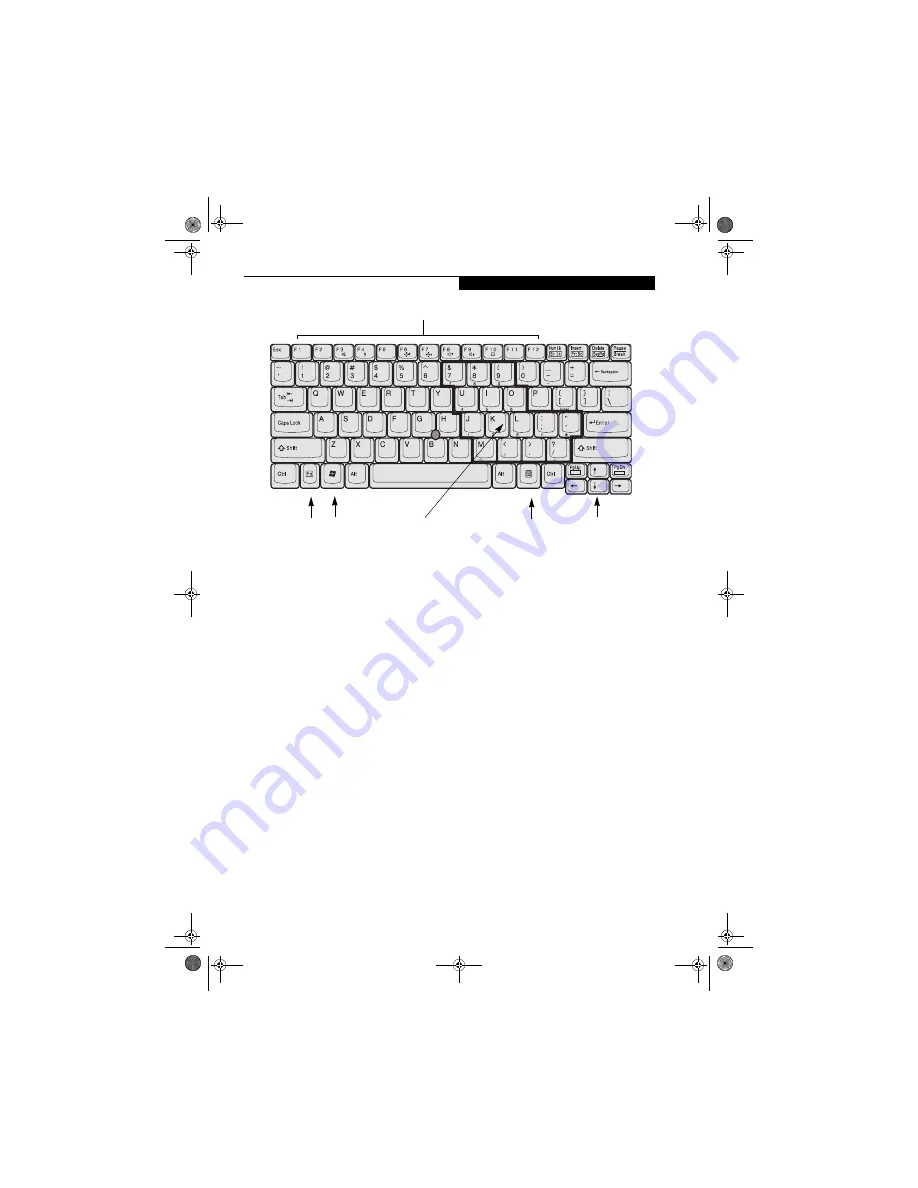
13
G e t t i n g t o K n o w Y o u r L i f e B o o k
Figure 2-10 Keyboard
Keyboard
USING THE KEYBOARD
Your Fujitsu LifeBook notebook has an integral 84-key
keyboard. The keys perform all the standard functions of
a 101-key keyboard, including the Windows keys and
other special function keys. This section describes the
following keys.
(Figure 2-10)
■
Numeric keypad: Your notebook allows certain keys to
serve dual purposes, both as standard characters and
as numeric and mathematical keys. The ability to tog-
gle between the standard character and numerical keys
is controlled through the [NumLk] key.
■
Cursor keys: Your keyboard contains four arrow
keys for moving the cursor or insertion point to the
right, left, up, or down within windows, applications
and documents.
■
Function keys: The keys labeled [F1] through [F12],
are used in conjunction with the [Fn] key to produce
special actions that vary depending on what program
is running.
■
Windows keys: These keys work with your Windows
operating system and function the same as the
onscreen Start menu button, or the right button
on your pointing device.
NUMERIC KEYPAD
Certain keys on the keyboard perform dual functions as
both standard character keys and numeric keypad keys.
NumLk can be activated by pressing the [NumLk] keys.
Turning off the NumLk feature is done the same way.
Once this feature is activated you can enter numerals 0
through 9, perform addition ( + ), subtraction ( - ),
multiplication ( * ), or division ( / ), and enter decimal
points ( . ) using the keys designated as ten-key function
keys. The keys in the numeric keypad are marked on the
front edge of the key to indicate their secondary func-
tions.
(Figure 2-10)
WINDOWS KEYS
Your LifeBook notebook has two Windows keys,
consisting of a Start key and an Application key. The
Start key displays the Start menu. This button functions
the same as your onscreen Start menu button. The
Application key functions the same as your right mouse
button and displays shortcut menus for the selected
item. (Please refer to your Windows documentation for
additional information regarding the Windows keys.)
(Figure 2-10)
CURSOR KEYS
The cursor keys are the four arrow keys on the keyboard
which allow you to move the cursor up, down, left and
right in applications. In programs such as Windows
Explorer, it moves the “focus” (selects the next item up,
down, left, or right).
(Figure 2-10)
End
Home
Fn Key
Start Key
Function Keys
Numeric Keypad
Application Key
Cursor Keys
(surrounded by heavy line)
clio.book Page 13 Friday, June 2, 2006 10:37 AM
Summary of Contents for LifeBook C1410
Page 1: ...Fujitsu LifeBook C1410 Notebook User s Guide clio book Page 1 Friday June 2 2006 10 37 AM ...
Page 2: ...clio book Page 2 Friday June 2 2006 10 37 AM ...
Page 9: ...1 Preface clio book Page 1 Friday June 2 2006 10 37 AM ...
Page 13: ...3 2 Getting to Know Your LifeBook Notebook clio book Page 3 Friday June 2 2006 10 37 AM ...
Page 33: ...23 3 Getting Started clio book Page 23 Friday June 2 2006 10 37 AM ...
Page 41: ...31 4 User Installable Features clio book Page 31 Friday June 2 2006 10 37 AM ...
Page 57: ...47 5 Troubleshooting clio book Page 47 Friday June 2 2006 10 37 AM ...
Page 71: ...61 6 Care and Maintenance clio book Page 61 Friday June 2 2006 10 37 AM ...
Page 77: ...67 7 System Specifications clio book Page 67 Friday June 2 2006 10 37 AM ...
Page 83: ...73 8 Glossary clio book Page 73 Friday June 2 2006 10 37 AM ...
















































